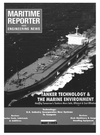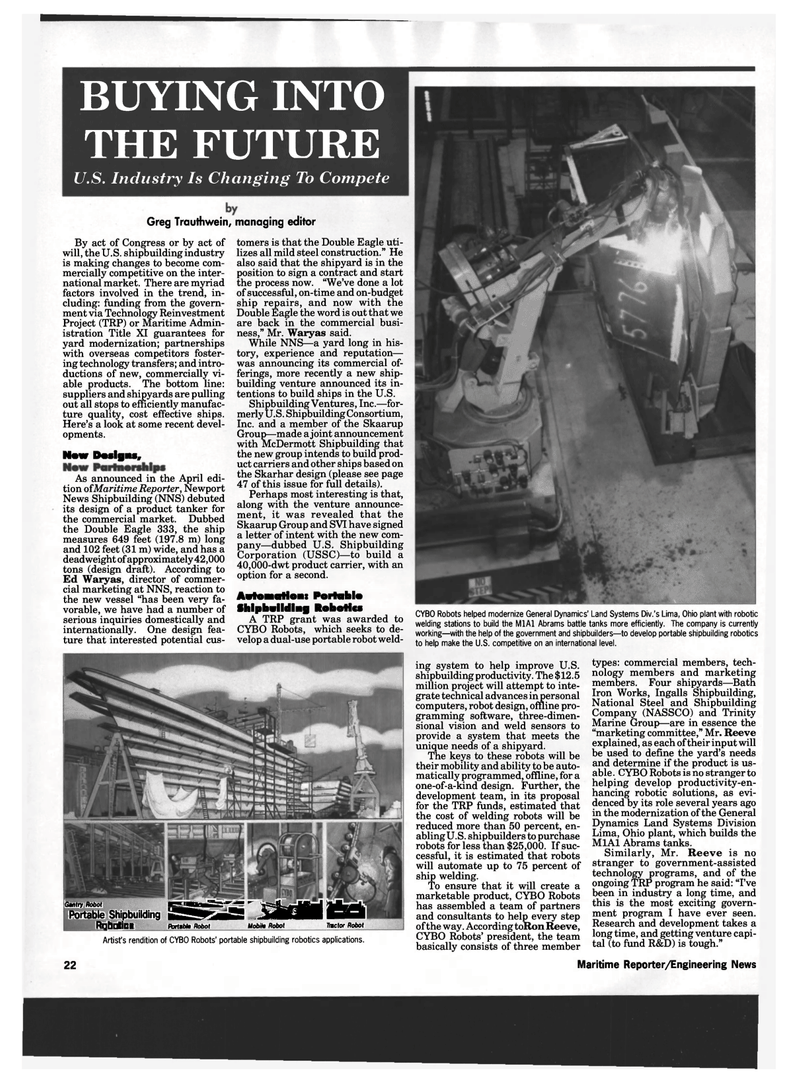
Page 20: of Maritime Reporter Magazine (May 1994)
Read this page in Pdf, Flash or Html5 edition of May 1994 Maritime Reporter Magazine
BUYING INTO
THE FUTURE
U.S. Industry Is Changing To Compete
Greg Trauthwein,
By act of Congress or by act of will, the U.S. shipbuilding industry is making changes to become com- mercially competitive on the inter- national market. There are myriad factors involved in the trend, in- cluding: funding from the govern- ment via Technology Reinvestment
Project (TRP) or Maritime Admin- istration Title XI guarantees for yard modernization; partnerships with overseas competitors foster- ing technology transfers; and intro- ductions of new, commercially vi- able products. The bottom line: suppliers and shipyards are pulling out all stops to efficiently manufac- ture quality, cost effective ships.
Here's a look at some recent devel- opments.
New Designs,
As announced in the April edi- tion ofMaritime Reporter, Newport
News Shipbuilding (NNS) debuted its design of a product tanker for the commercial market. Dubbed the Double Eagle 333, the ship measures 649 feet (197.8 m) long and 102 feet (31 m) wide, and has a deadweight of approximately42,000 tons (design draft). According to
Ed Waryas, director of commer- cial marketing at NNS, reaction to the new vessel "has been very fa- vorable, we have had a number of serious inquiries domestically and internationally. One design fea- ture that interested potential cus- managing editor tomers is that the Double Eagle uti- lizes all mild steel construction." He also said that the shipyard is in the position to sign a contract and start the process now. "We've done a lot of successful, on-time and on-budget ship repairs, and now with the
Double Eagle the word is out that we are back in the commercial busi- ness," Mr. Waryas said.
While NNS—a yard long in his- tory, experience and reputation— was announcing its commercial of- ferings, more recently a new ship- building venture announced its in- tentions to build ships in the U.S.
Shipbuilding Ventures, Inc.—for- merly U.S. Shipbuilding Consortium,
Inc. and a member of the Skaarup
Group—made a joint announcement with McDermott Shipbuilding that the new group intends to build prod- uct carriers and other ships based on the Skarhar design (please see page 47 of this issue for full details).
Perhaps most interesting is that, along with the venture announce- ment, it was revealed that the
Skaarup Group and SVI have signed a letter of intent with the new com- pany—dubbed U.S. Shipbuilding
Corporation (USSC)—to build a 40,000-dwt product carrier, with an option for a second.
Automation: Portable
Shipbuilding Robotics
A TRP grant was awarded to
CYBO Robots, which seeks to de- velop a dual-use portable robot weld-
CYBO Robots helped modernize General Dynamics' Land Systems Div.'s Lima, Ohio plant with robotic welding stations to build the M1A1 Abrams battle tanks more efficiently. The company is currently working—with the help of the government and shipbuilders—to develop portable shipbuilding robotics to help make the U.S. competitive on an international level. ing system to help improve U.S. shipbuilding productivity. The $12.5 million project will attempt to inte- grate technical advances in personal computers, robot design, offline pro- gramming software, three-dimen- sional vision and weld sensors to provide a system that meets the unique needs of a shipyard.
The keys to these robots will be their mobility and ability to be auto- matically programmed, offline, for a one-of-a-kind design. Further, the development team, in its proposal for the TRP funds, estimated that the cost of welding robots will be reduced more than 50 percent, en- ablingU.S. shipbuilders to purchase robots for less than $25,000. If suc- cessful, it is estimated that robots will automate up to 75 percent of ship welding.
To ensure that it will create a marketable product, CYBO Robots has assembled a team of partners and consultants to help every step of the way. According toRon Reeve,
CYBO Robots' president, the team basically consists of three member types: commercial members, tech- nology members and marketing members. Four shipyards—Bath
Iron Works, Ingalls Shipbuilding,
National Steel and Shipbuilding
Company (NASSCO) and Trinity
Marine Group—are in essence the "marketing committee," Mr. Reeve explained, as each of their input will be used to define the yard's needs and determine if the product is us- able. CYBO Robots is no stranger to helping develop productivity-en- hancing robotic solutions, as evi- denced by its role several years ago in the modernization of the General
Dynamics Land Systems Division
Lima, Ohio plant, which builds the
M1A1 Abrams tanks.
Similarly, Mr. Reeve is no stranger to government-assisted technology programs, and of the ongoing TRP program he said: "I've been in industry a long time, and this is the most exciting govern- ment program I have ever seen.
Research and development takes a long time, and getting venture capi- tal (to fund R&D) is tough."
Gsntry Robot WaowS^:' ' ^ iL^n^fli 7MPbSF"
Portable Shipbuilding SSSS^^aSS tm/mk
RpbotiCS Portable Robot Mobile Robot Tractor Robot
Artist's rendition of CYBO Robots' portable shipbuilding robotics applications. 22 Maritime Reporter/Engineering News

 19
19

 21
21
